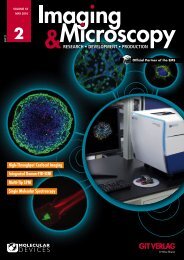SIM0216
Create successful ePaper yourself
Turn your PDF publications into a flip-book with our unique Google optimized e-Paper software.
ELECTRON MICROSCOPY<br />
Electro-Optical Characterization of 3D-LEDs<br />
Nondestructive Inspection of 4’’ Wafers in Bird’s Eye View by an FE-SEM<br />
Johannes Ledig, Sönke Fündling, Frederik Steib, Jana Hartmann, Hergo-Heinrich Wehmann, Andreas Waag<br />
The optimization of three dimensional LEDs with core-shell geometry requires adapted characterization<br />
methods with high spatial resolution. Integrating manipulators with small probe tips inside<br />
a cathodoluminescence scanning electron microscope (CL-SEM) enables the investigation of local<br />
electro-optical properties without the need for elaborate contact preparation. Moreover this allows<br />
for precise monitoring of the contact position by SEM imaging and to correlate electroluminescence<br />
and CL measurements.<br />
Introduction<br />
Three dimensional light emitting diodes<br />
(3D-LEDs) with a core-shell geometry<br />
are supposed to have substantial advantages<br />
over conventional planar LEDs<br />
[1–3]. The active area along the sidewalls<br />
of the structures can considerably<br />
be increased by high aspect ratios -<br />
leading to a lower current density inside<br />
the InGaN multi quantum well (MQW)<br />
at the same operation current per substrate<br />
area. Such LEDs were recently developed<br />
within the frame of the EU-FP7<br />
funded project GECCO and the DFG research<br />
group FOR1616. The production<br />
of devices out of arrays of these 3D-LEDs<br />
grown by metalorganic vapor phase epitaxy<br />
(MOVPE) is already scaling up to<br />
substrates with larger areas [4], generating<br />
a request for reliable characterization<br />
techniques of local electro-optical<br />
properties with high spatial resolution<br />
on different positions along the substrate.<br />
As also subsequent device processing<br />
should be performed on a wafer<br />
scale the applied techniques need to be<br />
non-destructive.<br />
For this purpose, an electron microscope<br />
equipped with a field emission<br />
gun (FEG) and a large specimen<br />
chamber capable for full stage scanning<br />
of 4-inch wafers also in bird’seye<br />
view has been installed in 2015 at<br />
the epitaxy competence center (ec²) of<br />
Braunschweig University of Technology.<br />
Optical characterization inside the<br />
view field of the SEM is possible by a<br />
CL setup, which consists of a parabolic<br />
mirror inserted below the pole piece<br />
and a spectrograph attached to the system.<br />
The chamber is actively isolated<br />
from vibrations and piezo controlled<br />
manipulators are mounted on the sample<br />
stage. This combination enables<br />
precise mechanical manipulation monitored<br />
by SEM imaging as well as electrical<br />
and electro-optical characterization<br />
of nanostructures. Using a triax cabling<br />
for the electrical probes, also high impedances<br />
(e.g. single nanostructures)<br />
can be analyzed in a two- or three-point<br />
configuration.<br />
Configuration Details<br />
The system is based on a Tescan Mira3<br />
GMH FE-SEM including scintillator<br />
based detectors for secondary electrons<br />
44 • G.I.T. Imaging & Microscopy 2/2016



